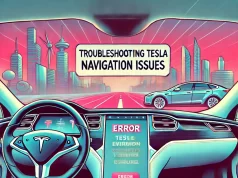Tesla Autopilot is a feature that enables the car to drive itself within its lane, using cameras and neural networks.
It is meant to assist the driver and reduce fatigue, but it is not a fully autonomous system. The driver still needs to pay attention and intervene when needed.
However, many Tesla owners have complained that Autopilot does not work well at night, especially on rural roads with oncoming traffic.
The car may brake abruptly or fail to recognize speed limits, road signs, or emergency vehicles. This can be dangerous and annoying for the driver.
Why Tesla Autopilot Not Working At Night?
The Radar-Vision Transition
One of the main reasons for Autopilot’s poor performance at night is the switch from radar to vision.
In 2021, Tesla announced that it would stop using radar sensors in its Model 3 and Model Y vehicles, and rely only on cameras and neural networks for Autopilot.
This was part of Tesla’s vision to achieve full self-driving capability using only computer vision.
However, this also meant that some features of Autopilot, such as adaptive cruise control and lane keeping, became less reliable in low-visibility conditions, such as rain, fog, snow, or darkness.
Radar sensors can see through these conditions and detect objects at a longer distance, while cameras may have difficulty seeing clearly or accurately.
The Data And Testing Gap
Another reason for Autopilot’s poor performance at night is the lack of data and testing.
Tesla collects data from its fleet of vehicles to train and improve its neural networks, but most of the data comes from daytime driving in urban areas.
Rural roads, where there are fewer markings, signs, and lights, may not be well represented in the data.
Moreover, Tesla does not test its software updates thoroughly before releasing them to the public, relying on its customers to provide feedback and report issues.
How to Fix Tesla Autopilot Not Working At Night Issue?
There are some steps that Tesla owners can take to fix or prevent Autopilot from malfunctioning at night. These include:
#1. Updating the software
Tesla regularly releases software updates that may fix bugs or improve features of Autopilot.
It is important to keep the software up to date and check the release notes for any changes or warnings.
For example, in September 2021, Tesla released an update that claimed to improve Autopilot’s ability to see and respond to emergency vehicles at night.
#2. Cleaning the cameras
The cameras are the main sensors for Autopilot, so they need to be clean and clear of any dirt, dust, ice, or snow.
It is recommended to clean the cameras regularly, especially before driving at night or in bad weather.
The cameras are located on the windshield, the side mirrors, the front fenders, the rear trunk, and the rear bumper.
#3. Rebooting the touchscreen
Sometimes, a simple reboot of the touchscreen can solve minor issues with Autopilot.
To reboot the touchscreen, press and hold both scroll wheels on the steering wheel until the screen turns off and then on again.
This may reset the system and restore the functionality of Autopilot.
#4. Speaking to Tesla support
If none of the above steps work, or if the problem persists or worsens, it is advisable to contact Tesla support for assistance.
They may be able to diagnose the issue remotely or schedule a service appointment to inspect the vehicle.
They may also provide feedback to the engineering team to improve Autopilot in future updates.
The Bottom Line
Tesla Autopilot is a remarkable feature that can make driving easier and more enjoyable, but it is not perfect.
It may not work well at night, especially on rural roads with oncoming traffic. This may be due to the switch from radar to vision, or the lack of data and testing.
Tesla owners can try to fix or prevent Autopilot from malfunctioning at night by updating the software, cleaning the cameras, rebooting the touchscreen, or speaking to Tesla support.
However, they should always remember that Autopilot is not a substitute for human attention and intervention, and they should always keep their hands on the wheel and their eyes on the road.




